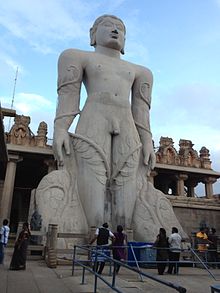Gommateshvara
| Bahubali | |
|---|---|
| Jain deity | |

The 59 ft high Gommateshwara statue at Shravanabelagola, Karnataka, was built in 981 A.D
|
|
| Other names | Gommateshwara |
| Height | 525 bows (157.5 metres) |
| Personal Information | |
| Born | Ayodhya |
| Moksha | Mount Kailash |
| Children | Somakirti (also known as Mahabala) |
| Parents |
|
Bahubali (English: One With Strong Arms), a much revered figure among Jains, was the son of Adinath, the first tirthankara of Jainism, and the younger brother of Bharata Chakravartin. He is said to have meditated motionless for one year in a standing posture (kayotsarga) and that during this time, climbing plants grew around his legs. After his year of meditation, Bahubali is said to have attained omniscience (Kevala Gyana). According to Jain texts, Bahubali attained liberation from the cycle of births and deaths (moksha) at Mount Kailash and is revered as a liberated soul (Siddha) by the Jains.
Bahubali is also called Gommateshwara because of the Gommateshwara statue dedicated to him. The statue was built by the Ganga dynasty minister and commander Chavundaraya; it is a 57-foot (17 m) monolith (statue carved from a single piece of rock) situated above a hill in Shravanabelagola in the Hassan district, Karnataka state, India. It was built in around 981 A.D. and is one of the largest free-standing statues in the world.
The Ādi purāṇa, a 9th-century Sanskrit poem, deals with the ten lives of the first tirthankara, Rishabhanatha and his two sons Bharata and Bahubali. It was composed by Jinasena, a Digambara monk.
...
Wikipedia
